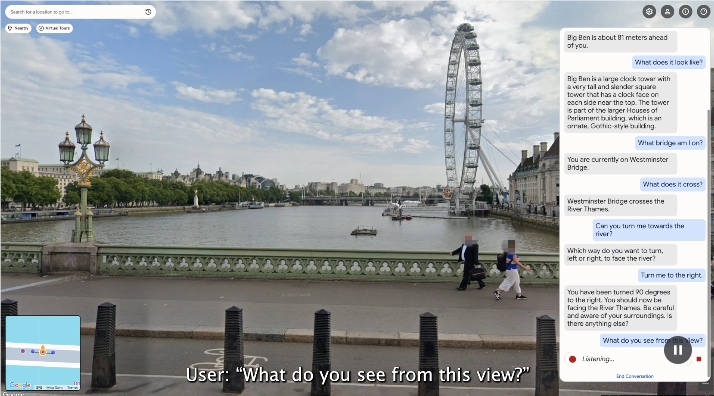Recently, it launched an innovative prototype system called StreetReaderAI, aimed at allowing blind and low-vision users to "explore" Google Street View without barriers - no longer passively receiving information, but interacting with the virtual environment in real time through natural language, truly achieving the freedom to independently explore urban spaces.
Multimodal AI Drives a Conversational Street View Experience
StreetReaderAI is not a simple voice broadcasting tool, but a multimodal AI system that deeply integrates computer vision, geographic information systems (GIS), and large language models. It can analyze street view images in real time and combine precise location data to generate structured and contextual audio descriptions. When users "stand" on a certain street, the system will proactively describe the surrounding environment: "You are facing a brick building, a cafe is on your left, a bus stop is on your right, and a crossroads is 50 meters ahead."

More importantly, the system supports intelligent conversational interaction. Users do not need to remember complex commands; they can simply ask questions as if talking to a person: "What is that building ahead?" "Is there a bank nearby?" "Where does this road lead?" The AI will provide accurate and coherent answers based on the current view and map data, making virtual exploration intuitive and natural.
Accessible Operation, Granting Users True Control
To ensure the operation is user-friendly for visually impaired individuals, StreetReaderAI features a minimalistic interaction method. Users can freely control the view rotation, forward and backward movement, and switching between street view points using voice commands or standard keyboard keys, without relying on screens or touch interfaces. This "voice + keyboard" dual-input approach caters to different user habits, truly achieving "what you ask is what you see, what you control is what you do."
Technology for Good: From Tool to Right
For a long time, digital maps and street view services have greatly facilitated public travel, but due to their heavy reliance on visual interfaces, they have excluded the visually impaired. The emergence of StreetReaderAI marks that accessibility technology is evolving from "auxiliary functions" to "equal experiences" - it is not just about providing information, but empowering users with the ability to actively explore, understand, and make decisions.
Although the system is currently still in the prototype stage and has not been integrated into the official Google Maps product line, its technical path has already shown clear potential for implementation. AIbase analysis suggests that as multimodal large models and spatial computing technologies mature, such accessibility AI will not only be limited to street views in the future, but can also expand to indoor navigation, public transport guidance, and even remote tours, truly building a "digitally perceivable and participable" world for everyone.
The significance of technology lies not only in breaking limits, but also in bridging gaps. StreetReaderAI may be just the first step, but the direction it illuminates is worth the entire industry following.
